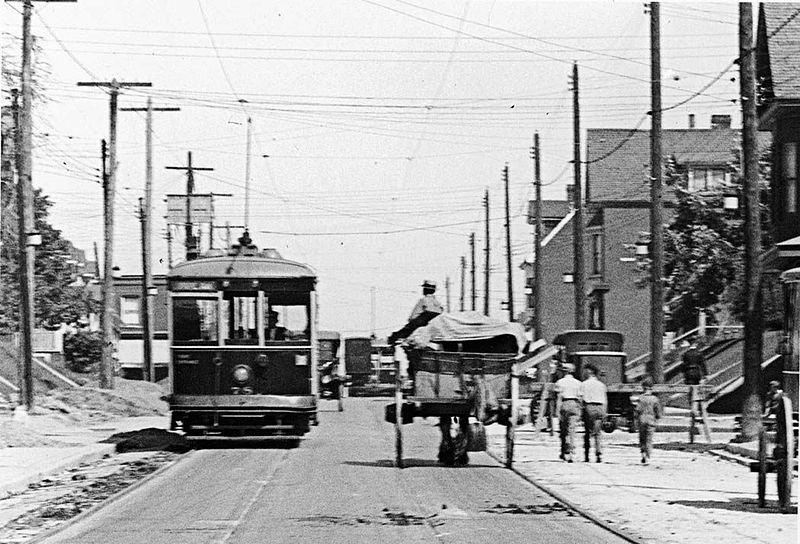 |
| Pape Avenue in 1922 |
A friend of mine recently gave me a pretty amazing book. It was written in the 1960s by a guy named Robert Thomas Allen. Apparently he was a "humourist"; mostly he comes across as a curmudgeonly old man pissed off that the Toronto he knew growing up in the '20s has given way to the modern age. Grumble grumble back in my day grumble grumble.
But the 120 pages are chock full of intimate details of what life was like, christ, nearly a hundred years ago now. One of my favourite bits is when he talks about all the animals that used to be wandering around:
"One thing wrong with these times of increasing populations and expanding cities is that people only know people. Nobody knows animals any more, the way they did when there were delivery horses and flocks of sparrows on city streets; chickens, geese, and an occasional cow in suburban backyard; and every boy longed to own a guinea pig, rabbit, white rat, ferret, or flock of pigeons, which we found a lot more interesting than human beings...
"There was also a black bear chained over in Phippin's Lumber Yard on Pape Avenue, where you could stand for hours amid the scent of pine shavings, looking at the strange, foreign, snuffing, beady-eyed creature as it sat with its legs spread, front paws dangling, patches of its bare belly as black as shoe leather. It was practically like taking a trip to the Yukon. There was a CNR conductor on Browning Avenue with a racoon, and a kid on Arundel Avenue with a crow, and a woman on Bowden with a parrot that she used to put out on her porch about the time we went to school. We'd keep ourselves late standing there calling without the slightest effect, "Polly want a cracker? Polly want a cracker?"
"We knew all the horses that appeared on the street pulling bakers' and butchers' wagons... There was a horse that used to graze in a field at the top of Broadview Avenue... Now and then a delivery horse took the bit in his mouth and you'd hear the cry go up, "A runaway! Here comes a runaway!" and there'd be the electrifying sight of a horse coming up the front lawns over petunias and wire fences with a bread wagon careening behind it. I used to read in the Boys' Own Annual how to stop a runaway horse by trotting along beside it with my Boy Scout hat on, grabbing one shaft in my left hand and the dangling reigns in my right, gradually bringing the horse to a gentle stop, then turning to the father of my girl, saluting smartly, and saying, "Is this your bread wagon, sir?" But what I used to do when a runaway horse came up the street was to find myself on the veranda, without remembering how I got there, thinking what an impossible life a hero led.
-----
He goes on to talk about all the animal stories he used to love reading, some by Toronto writers like Charles G.D. Roberts and Ernest Thompson Seton, who I recently wrote about in my post "Two Awesome Moustaches vs. The President of the United States", here.
As far as I can tell, When Toronto Was For Kids is out of print, but you can find a copy at the Toronto Reference Library. You just can't take it out. Info here. Oh and I'm pretty sure he grew in the '20s, because he keeps talking about people who've recently returned from the First World War, but he never actually gives any dates.
-----
He goes on to talk about all the animal stories he used to love reading, some by Toronto writers like Charles G.D. Roberts and Ernest Thompson Seton, who I recently wrote about in my post "Two Awesome Moustaches vs. The President of the United States", here.
As far as I can tell, When Toronto Was For Kids is out of print, but you can find a copy at the Toronto Reference Library. You just can't take it out. Info here. Oh and I'm pretty sure he grew in the '20s, because he keeps talking about people who've recently returned from the First World War, but he never actually gives any dates.








No comments:
Post a Comment
Note: Only a member of this blog may post a comment.